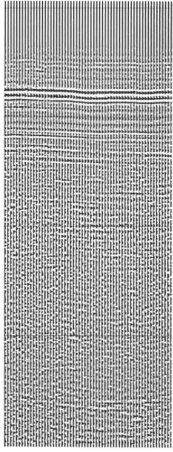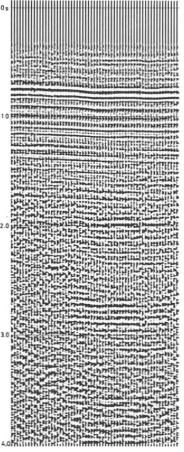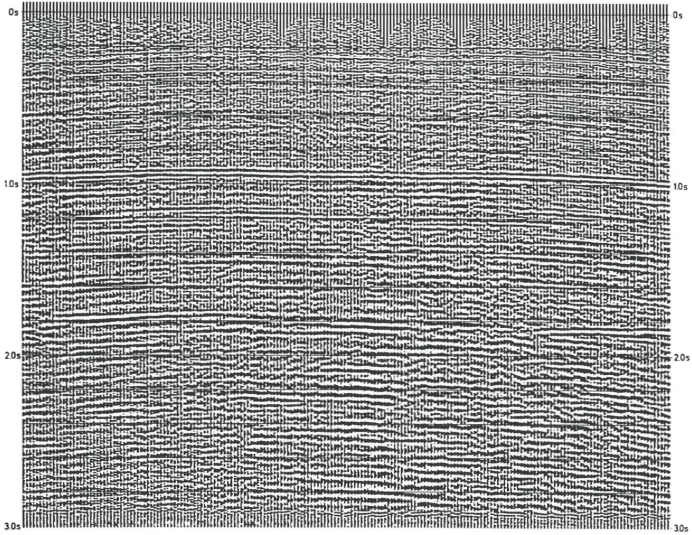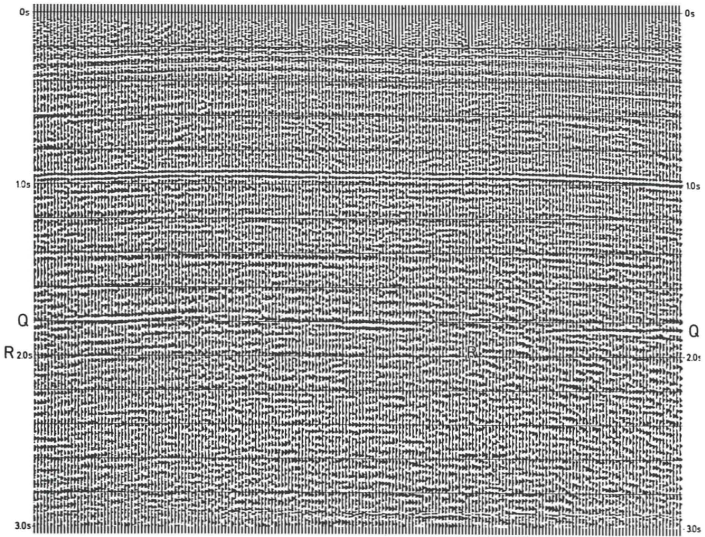Multiple-Attack
Prof. Dr. Th. Krey und Dr. H. Wachholz
Wird die von unten kommende Folge von Reflexionsimpulsen von der Erdoberfläche wieder nach unten zurückgeworfen, so entstehen nach abermaliger Reflexion im Untergrund die sogenannten erdoberflächenmultiplen Reflexionen. Sie überlagern oft wichtige primäre Reflexionen, womit deren Auswertung erschwert oder unmöglich gemacht wird. Bei Anwendung der Mehrfachüberdeckung (Common-Reflection-Point-Method) tritt eine Schwächung dieser Multiplen ein, wenn die Moveoutzeiten zwischen pnmaren und multiplen Reflexionen genügend große Unterschiede aufweisen. Sind diese Unterschiede jedoch zu klein, müssen andere Wege beschritten werden.
Eine Dekonvolution mit großer Operatorlänge (Langzeitdekonvolution) kann Erfolge bringen. Hierbei muß aber die Operatorlänge u. U. größer sein als die halbe Reflexionszeit der interessierenden primären Reflexionen j daher führt die Langzeitdekonvolution u. U. nicht zum gewünschten Erfolg.
Hier ist nun von PRAKLA-SEISMOS ein Datenverarbeitungsprogramm entwickelt worden, das auf Ideen zurückgeht, die bereits 1965 in einer Patentschrift *) zum Ausdruck gebracht worden sind. Dieses Programm heißt LongLeg-Multiple-Attack (LLMA), weil es solche multiple Reflexionen "angreifen" soll, deren Strahlengänge (Iegs) sich aus denen von zwei oder mehr primären Reflexionen zusammensetzen, von denen jede eine relativ lange Laufzeit, z. B. von 0,5 bis 1,5 Sekunden besitzt.
Der Grundgedanke des neuen Prozesses ist folgender: Es wird eine zeitabhängig bewichtete Multiplenspur erzeugt und diese Multiplenspur wird von der Originalspur abgezogen, so daß nur die Primärreflexionen " übrigbleiben".
Die Multiplenspur könnte durch Retrokorrelation, d. h. Faltung der Spur mit sich selbst, hergestellt werden. Will man jedoch diese Multiplenspur von der Originalspur abziehen, so treten Schwierigkeiten auf, weil das 8ezugsniveau und damit der Nullpunkt der Originalspur nicht mit dem Nullpunkt der Erdoberflächenreflexion zusammenfallen. Zwischen Originalspur und Multiplenspur treten unbekannte zeitliche Verschiebungen auf, deren Kompensation nur bei genauer Kenntnis des Reflexionsmechanismus an der Erdoberfläche möglich wäre. Außerdem wird die Form des Signals durch die Faltung gegenüber der Originalspur stark verändert. 8eide Schwierigkeiten können dadurch gelöst werden, daß man nicht die Spur mit sich selbst, sondern mit der Autokorrelation abfaltet.
Sind in der Originalspur Multiple mit merklicher Amplitude vorhanden (und nur in diesem Fall soll eine von Null verschiedene Multiplenspur entstehen), so ist nach Anstey in der Autokorrelation unter anderem auch die ursprüngliche Seismogrammspur enthalten. Man braucht also nur alle anderen Ereignisse, die in der Autokorrelation enthalten sind und nicht zum Seismogramm gehören, wegzublenden, um näherungsweise eine Seismogrammspur zu haben, bei der der Nullpunkt zeitlich genau in der zurückreflektierenden Erdoberfläche liegt. Damit ist die erste Schwierigkeit beseitigt; zur Lösung der zweiten wird die Originalspur vor der Autokorrelation mit einem Kurzzeitoperator dekonvolutioniert. Man hat dann in der Autokorrelation näherungsweise eine Spikespur zur Verfügung. Die so behandelte Autokorrelation wird mit der Originalspur abgefaltet und damit die rohe Multiplenspur erhalten. Diese wird noch mit einem Gewicht versehen, das in bekannter Weise so bestimmt ist, daß die Energie der resultierenden Spur (Ausgangsspur minus Multiplenspur) zu einem Minimum wird. Die 8ewichtung kann für die gesamte Spur entweder konstant oder zeitabhängig vorgenommen werden.
Die Abbildung 1 zeigt in der Mitte unterhalb von ca. 1,5 s zahlreiche starke Reflexionen. Nach Anwendung des LLMA-Prozesses (Abb. 2) sind diese Reflexionen fast ganz verschwunden. Tatsächlich handelte es sich um multiple Reflexionen, die durch Mehrfachüberdeckung nicht gelöscht werden konnten, da die nach oben konkave Krümmung der oberen Horizonte eine Angleichung der Moveoutzeiten der multiplen Reflexionen an die der primären bewirkt.
In Abbildung 3 war der maximale Schuß-Geophon abstand zu klein, um unterhalb von einer Sekunde noch multiple Reflexionen durch Mehrfachüberdeckung abzuschwächen. Abbildung 4 zeigt, daß nach Anwendung des LLMA-Prozesses Horizont Q deutlich hervortritt und daß außerdem unter Horizont Q der Horizont R sichtbar wird.
Long-Leg Multiple-Attack
If the sequence of reflection pulses, arnvlng from below, is reflected downwards again at the earth's surface, further reflection processes in the subsurface will generate the so-called surface multiple reflections. They often interfer with important primary reflections whose interpretation is subsequently impaired or made impossible. An attenuation of these multiples occurs by applying multiple coverage (common-reflection-point method) if the moveout times of primary and multiple reflections exhibit sufficiently large differences. Alternate procedures have to be adopted, however, if these differences are too small.
In so me cases, a deconvolution with large operator length can be successful. Yet the operator length has to be larger than half the reflection time of the interesting primary reflections. 'This deconvolution, therefore, does not necessarily achieve the desired success.
PRAKLA-SEISMOS has now developed a data-processing program which is based on ideas that have already been expressed in a patent application in 1965 *). This program has been named "Iong-Ieg multiple-attack" (LLMA)", because it is to "attack" such multiple reflections that are composed of two or more primary reflections of which each has a relatively long travel time, for example, from 0.5 to 1.5 seconds.
The basic idea in the new procedure is as folIows:
A trace of multiple reflections is generated which is weighted in a time-varying manner and this multiple trace is subtracted from the original trace, so that only primary reflections "remain".
The multiple trace might theoretically be generated by retro-correlation, i. e. convolution of the trace with itself. However, if one tries to subtract this multiple trace from the original trace, difficulties will arise because the datum level and, herewith, the zero level of the original trace, do not coincide with the zero level of the multiple reflection. Unknown time shifts occur between original trace and multiple trace whose compensation could only be effected by an accurate knowledge of the reflection mechanism at the earth's surface. Moreover, by convolution the shape of the signal is strongly alte red as compared to the original trace. Both difficulties can be solved by convolving the trace with its auto-correlation.


Fig.1
If the original trace contains multiples with noticeable amplitude (and only in this case a multiple trace will be considered), the auto-correlation also contains, according to Anstey, the original seismogram trace.
One only needs, therefore, remove all other events wh ich are contained in the auto-correlation and which do not belong to the seismogram, to get a seismogram trace in which the zero level lies accurately at the time of the back-reflecting surface of the earth. With this, the first difficulty is removed; to solve the second one we deconvolve the original trace before auto-correlation with an operator of short to medium length. The autocorrelation is then nearly aspike trace. The autocorrelation so processed and then convolved with the original trace results in the rough multiple trace. This will still be weigthed in a well-known manner so that the energy of the resulting trace (trace minus multiple trace) becomes aminimum. This weighting can be performed either at a constant rate or be made time-variant.
Fig. 1 shows in the centre below approximately 1.5 s numerous strong reflections. After applying the LLMA process (fig. 2) these reflections nearly disappear altogether. Actually, those were multiple reflections which could not be attenuated as the upwardly concave curvature of the upper horizons causes near coincidence of moveout times of the multiple reflections with those of the primary reflections.
In figure 3 the maximum shot-geophone spacing was too small to attenuate multiple reflections beneath 1 s by multiple coverage.
Figure 4 shows that the application of the LLMA process brings forth Horizon Q distinctly and below Q, Horizon R becomes visible as weil.

Fig. 3

Fig. 4